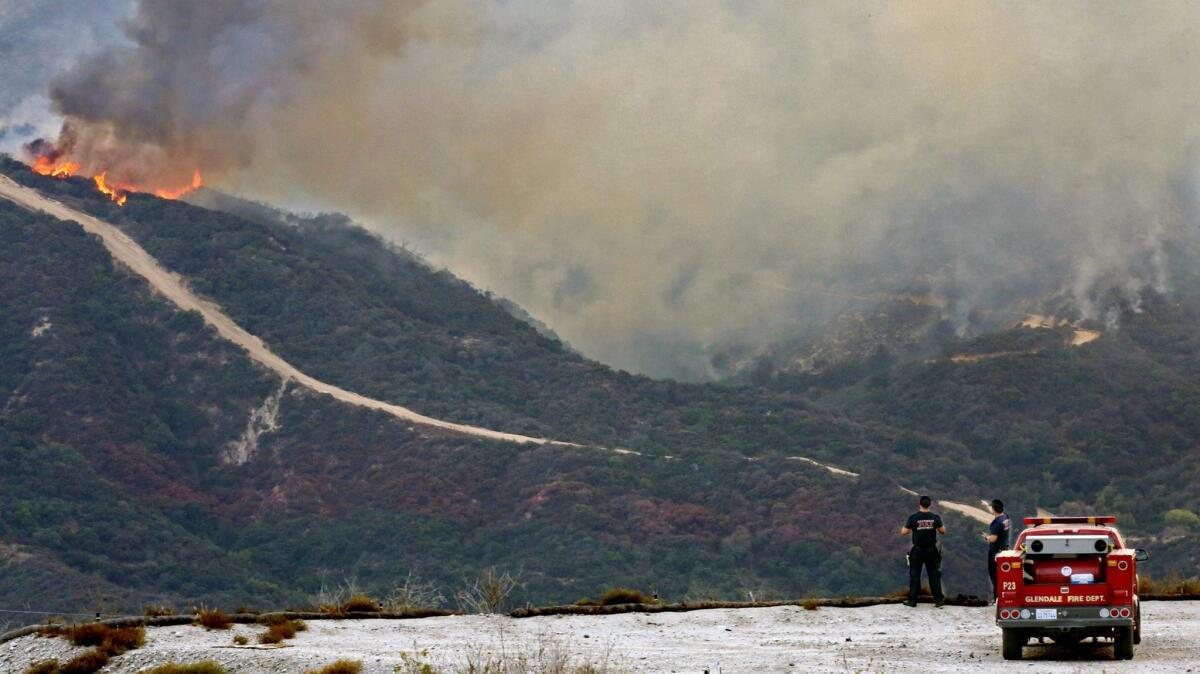Soil in La Tuna Fire burn area causes concerns about potential mudslides

- Share via
Several canyons in the Verdugo Mountains may be susceptible to mudslides in the coming months, so a community meeting was held last Saturday to go over ways Burbank residents impacted by the La Tuna Fire earlier this year can prepare for rainfall this winter.
State Sen. Anthony J. Portantino (D-La Cañada Flintridge) convened a panel at Woodbury University to address safety issues following the Sept. 1 fire that scorched 7,000 acres, jumped the Foothill (210) Freeway, destroyed five homes and required more than 300 evacuations.
Panel members covered strategies to protect properties from mudslides, how the fires have impacted plants and wild animals in the area and the history of local wild fires.
“If you lose one home, that’s one too many,” Portantino said.
The Los Angeles County Department of Public Works sent out more than 40 engineers recently to survey all the of the burn areas around La Tuna Canyon, and they identified flood-control areas potentially impacted by the fire.
Working with Burbank officials, they knocked on doors of homes on “more than 500 to 600” properties to address mudslide concerns and discuss steps that can taken before the rains come.
Eric Baumgardner, Burbank’s emergency manager, said Sunset Canyon in the Country Club Drive area, Stout Canyon and Wildwood Canyon, in addition to areas above Burbank Estates, such as Brace Canyon, present “significant” debris-flow concerns.
“We’re pretty confident,” Baumgardner said of their research, adding that all residents who received mitigation advice can pick up sandbags at Brace Canyon Park to protect their property.
“For those who were directly impacted [by the fire], we have pre-filled sandbags,” he said. “Start mitigating your property early. Once it starts raining, it’s too late.”
The city is also placing barriers and K-rails strategically in areas where the terrain is steep, Baumgardner said.
Jon E. Keeley, a fire ecologist with the U.S. Geological Survey, gave an overview of the history of fires in the region, erosion scenarios and the short- and long-term threats.
“The fires we get in Southern California are very high intensity. They burn through shrub land and decimate the landscape. It looks like nothing is left,” he said.
“By the next couple of months, the landscape should recover with lots of green. These are eco-systems that are adapted to fires,” he added. “They’ve had a very long history with fire, and some are what we call fire dependent. Some of these species cannot regenerate unless they have a fire.”
Keeley went through the natural and human steps taken to enhance recovery efforts to local ecosystems following fires.
One effort Keeley, Baumgardner and Portantino cautioned residents against is “rogue seeding,” where residents undertake a grassroots effort to re-seed landscapes rather than let natural growth or professional efforts take over.
“They need a precipitation regime and gradual rain shift to germinate, establish roots and hold the soil in spring,” Keeley said. “Southern California rainfall patterns aren’t like that. We get big storms in the late fall and, generally, the seeds we put out do very little good. We have studies that show that seeding after [a] fire does very little good.”
Keeley added that, while erosion control and emergency-response protocols are important in the short term, figuring out how to prevent fires in La Tuna Canyon for the next 20 years is just as imperative, citing that native shrubs can be lost.
Michael Miranda and Patricia Wood, civil engineers with the Los Angeles County Department of Public Works, said that after their extensive field work, it was determined that in the 7,000-acre area, there’s a potential that 1 million cubic yards of soil may erode and cause mudslides.
“The goal is to deflect the flow around your home to the street without impacting your neighbor,” Wood said.
Twitter: @lamarkkellam